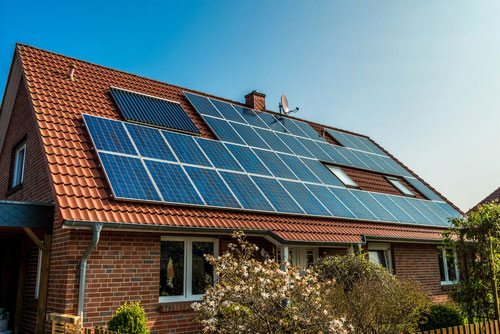Exploring the Benefits of Solar Development in the 21st Century
As the world heads into the 21st century, the need to transition to renewable sources of energy has become increasingly urgent. Solar energy is among the most promising of these renewable sources, and its development and implementation is often heralded as a key component of a clean energy future. Solar energy is a clean, reliable, and abundant source of energy, and its development offers a range of benefits both to the environment and to the economy.
From an environmental standpoint, the benefits of solar energy are obvious. Solar energy is an emission-free source of energy, meaning that its usage does not contribute to air pollution or climate change. In addition, solar energy is a renewable energy source, meaning that it is available without the need to extract finite resources such as coal, oil, and natural gas. This helps to reduce the environmental impact associated with the extraction and usage of these resources.
The economic benefits of solar energy are also significant. Solar energy is becoming increasingly affordable, with prices dropping significantly over the past decade due to advances in technology and economies of scale. The installation of solar energy systems can also provide jobs, both in the installation and maintenance of these systems, as well as in the manufacturing of solar panels and other components. Furthermore, the usage of solar energy can help to reduce energy costs for both businesses and individuals, as solar energy is often cheaper than traditional sources of energy.
Overall, the development of solar energy in the 21st century is poised to provide a range of benefits both to the environment and to the economy. As the world continues to transition to renewable sources of energy, solar energy will be a key part of this effort, and its development should be encouraged and supported.
Exploring the Cost of Solar Development in the 21st Century
The 21st century has been a time of tremendous progress for the development of solar energy. Solar energy offers an affordable and clean alternative to traditional sources of energy, making it an attractive option for people and businesses alike. However, the cost of solar development has been a major obstacle in its widespread adoption. This article explores the cost of solar development in the 21st century and the challenges associated with it.
The most significant cost associated with solar development is the cost of installation. Solar panels and other equipment necessary for solar energy production can be expensive, and installation costs can vary significantly depending on the size and complexity of the project. In addition, solar energy systems require ongoing maintenance, which adds to the cost of ownership.
In some cases, government incentives can help offset the cost of solar development. For example, the federal government offers tax credits for homeowners and businesses that install solar energy systems. These credits can help reduce the cost of solar energy production, making it more accessible and affordable for those wishing to invest in it.
The cost of solar energy has also been impacted by technological advancements. Solar technology has become more efficient over the years, allowing for more cost-effective production of solar energy. Additionally, the cost of solar energy has been reduced as a result of increased competition in the industry.
Despite these advancements, the cost of solar energy is still too high for many people and businesses to afford. This is especially true in areas that don’t have access to government incentives or other forms of financial assistance. In addition, the cost of solar energy is often higher in rural and low-income areas, further limiting its availability.
The cost of solar development in the 21st century continues to be a major obstacle for the widespread adoption of solar energy. However, with technological advancements and increased competition, the cost of solar energy is becoming more affordable and accessible. With continued investment and the support of government incentives, the cost of solar energy could become more affordable for everyone in the near future.
Examining the Regulatory Challenges of Solar Development in the 21st Century
In the 21st century, solar energy has emerged as a viable, sustainable alternative to traditional energy sources, such as oil and gas. However, the development of solar energy systems is fraught with a variety of regulatory challenges.
One of the major challenges is the cost of installation. While the cost of solar energy has dropped significantly in recent years, the upfront cost of installing solar energy systems is still high. This is due to the fact that solar energy systems must meet specific energy efficiency standards, which can be costly and time-consuming to achieve. Additionally, solar energy systems must be installed in accordance with local building codes and regulations, which can also be costly and time-consuming.
Another challenge is that of access to financing. Many solar energy projects require a large initial investment, which can be difficult for individuals or small businesses to obtain. This can be especially true in areas where the financing market is not well-developed. Additionally, some states impose restrictions on the types of financing that can be used for solar energy projects, making it even more difficult to obtain the necessary funds.
Finally, there is the challenge of navigating the increasingly complex web of state and federal regulations. Many states have enacted their own solar energy regulations, which can be confusing and difficult for solar developers to understand. Additionally, the federal government has also implemented a variety of incentives and tax credits for solar energy projects, but these can be difficult to access and often require expert guidance.
Clearly, the development of solar energy systems is not without its challenges. However, with the right tools and resources, these challenges can be overcome and solar energy can become a viable, sustainable energy source for the 21st century.
Investigating the Impact of Solar Development on the Environment
As climate change continues to be an increasingly pressing issue, many countries are turning to renewable energy sources such as solar power to reduce their emissions. However, the environmental impacts of solar development are still largely unknown. This article aims to investigate the potential environmental impacts of solar development and assess whether they are positive or negative.
The first potential environmental impact of solar development is the destruction of habitats due to the clearing of land for solar panel arrays. The construction of these arrays requires the clearing of land, which can have a devastating impact on local ecosystems. Native habitats are destroyed, and the local flora and fauna are displaced. This can have a devastating effect on the biodiversity in an area and can even cause species extinction.
The second potential environmental impact of solar development is water use. Solar power plants require large amounts of water for cooling. This can be a major issue in areas that are already water-stressed, as it means that water resources are diverted away from other uses. Additionally, the waste water from the cooling process can contain hazardous chemicals that can pollute local water sources.
The third potential environmental impact of solar development is air pollution. Solar panels produce electricity through photovoltaic cells, which require the use of hazardous materials such as cadmium and lead. These materials can be released into the atmosphere during the manufacturing process, leading to air pollution.
Finally, the disposal of solar panels can also have an environmental impact. Solar panels contain hazardous materials and require proper disposal to avoid contamination of the surrounding environment. Additionally, the disposal of solar panels can be expensive, which can lead to them being dumped in landfills, leading to further environmental damage.
Overall, it is clear that solar development can have both positive and negative impacts on the environment. While it can reduce emissions and provide a renewable source of energy, it can also lead to habitat destruction, water use, air pollution, and improper disposal of solar panels. It is therefore important to assess the environmental impacts of solar development carefully before proceeding with any projects.
Exploring the Potential of Solar Development for Developing Countries in the 21st Century
As the world moves into the 21st century, the potential of solar development to provide energy for developing countries is becoming increasingly important. Solar energy is a clean, renewable and cost-effective form of energy, and the technology is rapidly advancing to make it more efficient and accessible. This is a game-changer for developing countries, many of which lack access to reliable energy sources and often struggle to afford traditional energy sources.
Solar energy has the potential to revolutionize energy production in developing countries. It is a simple, low-cost technology that can be used in remote areas that are not connected to the grid. In addition, solar energy is a renewable source of energy, meaning it is not depleted by usage and can be used for generations to come. And, as the technology continues to improve, solar energy is becoming increasingly affordable, making it a viable option for developing countries.
Solar power projects are already beginning to take off in developing countries. In India, for example, the government has set an ambitious target of installing 100 gigawatts of solar power by
- This has led to a surge of investment in solar projects and an increase in the number of jobs created by the industry. In Bangladesh, solar energy is being used to power rural villages, and the government is now pushing for the installation of solar panels in all villages by
- The potential of solar development in developing countries is exciting, and it is only going to grow in the years to come. Solar energy could provide a clean, reliable source of energy to millions of people who currently lack access to reliable electricity. It could also reduce the strain on existing energy grids, helping to reduce energy costs for everyone. With advances in technology and investment in solar projects, developing countries can look forward to a brighter future powered by solar energy.






